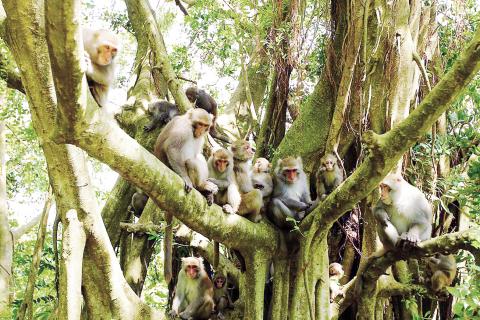In a bid to counter the headache monkeys pose to residents and farmers in Kaohsiung, people caught feeding monkeys are to be fined between NT$5,000 and NT$10,000, Kaohsiung Agriculture Bureau Deputy Director Cheng Chin-fu (鄭清福) said yesterday.
Since the promulgation of the regulations in 2012, the city government has focused on dissuading people from feeding monkeys and has only handed down fines when warnings were ignored, Cheng said.
However, starting on Monday next week, there will be no warnings and fines will be issued on the spot in accordance with the Kaohsiung Autonomous Regulations for Wildlife Conservation (高雄市野生動物保育自治條例) amended earlier this month by the city council.

Photo: CNA, courtesy of the Shoushan National Nature Park preparatory office
People who provide information, such as video recordings or photographs, that help identify those feeding monkeys could receive up to 20 percent of the fine as a reward, Chen added.
The city government made the decision after years of trying to dissuade people from feeding Taiwanese macaques on Shoushan (壽山) and Chaishan (柴山) in particular, the Chinese-language United Daily News reported yesterday.
The monkey population has exploded on the two mountains because of the practice, it said.
Incidents such as mountain climbers being attacked or visitors having their food stolen have also increased, spurring the authorities to adopt more stringent measures, it said.
There are between 1,400 and 1,600 monkeys on Chaishan, the report said, citing Chen Chen-chih (陳貞志), a professor at the Institute of Wildlife Conservation at National Pingtung University of Science and Technology.
However, officials are hopeful that the measures would finally keep visitors from feeding them, it added.
The monkeys are also a problem for local farmers. The bureau has over the years tried different methods, including using trained dogs, firecrackers, electric wire and even monkey-shaped scarecrows to scare away the animals that damage farmland, but to no avail, the report said.
National Sun Yat-sen University, which is near Chaishan, also feels the effects of badly behaved monkeys, which often break into student dormitories looking for food. Campus security guards chase them away with paintball guns and dogs or set traps, but such efforts have only had a limited effect.
Groups of volunteers have been dispatched to key entrances at the mountain parks to ask visitors not to feed the monkeys, but this has also had little effect, the report said.

LONG FLIGHT: The jets would be flown by US pilots, with Taiwanese copilots in the two-seat F-16D variant to help familiarize them with the aircraft, the source said The US is expected to fly 10 Lockheed Martin F-16C/D Block 70/72 jets to Taiwan over the coming months to fulfill a long-awaited order of 66 aircraft, a defense official said yesterday. Word that the first batch of the jets would be delivered soon was welcome news to Taiwan, which has become concerned about delays in the delivery of US arms amid rising military tensions with China. Speaking on condition of anonymity, the official said the initial tranche of the nation’s F-16s are rolling off assembly lines in the US and would be flown under their own power to Taiwan by way

OBJECTS AT SEA: Satellites with synthetic-aperture radar could aid in the detection of small Chinese boats attempting to illegally enter Taiwan, the space agency head said Taiwan aims to send the nation’s first low Earth orbit (LEO) satellite into space in 2027, while the first Formosat-8 and Formosat-9 spacecraft are to be launched in October and 2028 respectively, the National Science and Technology Council said yesterday. The council laid out its space development plan in a report reviewed by members of the legislature’s Education and Culture Committee. Six LEO satellites would be produced in the initial phase, with the first one, the B5G-1A, scheduled to be launched in 2027, the council said in the report. Regarding the second satellite, the B5G-1B, the government plans to work with private contractors

‘NARWHAL’: The indigenous submarine completed its harbor acceptance test recently and is now under heavy guard as it undergoes tests in open waters, a source said The Hai Kun (海鯤), the nation’s first indigenous defense submarine, yesterday began sea trials, sailing out of the Port of Kaohsiung, a military source said. Also known as the “Narwhal,” the vessel departed from CSBC Corp, Taiwan’s (台灣國際造船) shipyard at about 8am, where it had been docked. More than 10 technicians and military personnel were on deck, with several others standing atop the sail. After recently completing its harbor acceptance test, the vessel has started a series of sea-based trials, including tests of its propulsion and navigational systems, while partially surfaced, the source said. The Hai Kun underwent tests in the port from

MISSION: The Indo-Pacific region is ‘the priority theater,’ where the task of deterrence extends across the entire region, including Taiwan, the US Pacific Fleet commander said The US Navy’s “mission of deterrence” in the Indo-Pacific theater applies to Taiwan, Pacific Fleet Commander Admiral Stephen Koehler told the South China Sea Conference on Tuesday. The conference, organized by the Center for Strategic and International Studies (CSIS), is an international platform for senior officials and experts from countries with security interests in the region. “The Pacific Fleet’s mission is to deter aggression across the Western Pacific, together with our allies and partners, and to prevail in combat if necessary, Koehler said in the event’s keynote speech. “That mission of deterrence applies regionwide — including the South China Sea and Taiwan,” he